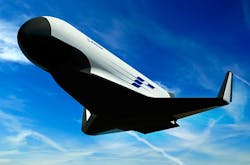Boeing to continue work on developing XS-1 reusable hypersonic unmanned spacecraft
ARLINGTON, Va., 28 July 2015. U.S. military researchers are pushing forward with a project to design an reusable hypersonic unmanned spacecraft able to carry and deploy 3,000-to-5,000-pound satellites to low-Earth orbit (LEO) for less than $5 million per launch.
Officials of the U.S. Defense Advanced Research Projects Agency (DARPA) in Arlington, Va., announced a $6.6 million contract Monday to the Boeing Co. Defense, Space & Security segment in Huntington Beach, Calif., for phase IB work on the hypersonic Experimental Spaceplane (XS-1) program.
The DARPA XS-1 program seeks to design a reusable spacecraft to support not only next-generation launch for government and commercial satellites, but also as a global-reach hypersonic and space-access aircraft.
DARPA announced the XS-1 program in 2013, and in 2014 chose three teams to compete for an eventual XS-1 flight contract. The program still is in its first phase.
The three XS-1 company teams chosen last year are Northrop Grumman Corp. in Falls Church, Va., Scaled Composites in Mojave, Calif., and Virgin Galactic in Pasadena, Calif.; Masten Space Systems Inc. in Mojave, Calif., and XCOR Aerospace in Mojave, Calif.; and Boeing and Blue Origin in Kent, Wash.
Related: Air Force asking industry for enabling technologies for future hypersonic munition
For this phase IB contract modification, Boeing will continue developing the XS-1 demonstration concept, substantiating identified core component technologies, mitigating risk, developing a technology maturation plan (TMP), and performing several demonstration tasks. The contract modification brings the total cumulative face value of the Boeing's XS-1 work from $10 million to $16.6 million.
The XS-1 program seeks to lower satellite launch costs by developing a reusable hypersonic unmanned vehicle with costs, operation, and reliability similar to traditional aircraft, DARPA officials say.
The vehicle is envisioned to operate from a clean pad, with a small ground crew, and inexpensive infrastructure to enable routine daily operations and flights from a wide range of locations. XS-1 seeks to deploy small satellites faster and more affordably than is possible today, while demonstrating technology for next-generation space and hypersonic flight for government and commercial users.
XS-1 envisions that a reusable first stage would fly to hypersonic speeds at a suborbital altitude, when one or more expendable upper stages would separate and deploy a satellite into low-Earth orbit.
story continues below
The reusable hypersonic aircraft then would return to Earth, land, and be prepared for the next flight. Key XS-1 technical goals include flying 10 times in 10 days, achieving speeds faster than Mach 10 (7,600 miles per hour) at least once and launching a payload to orbit. The program also seeks to reduce the cost of access to space for small payloads by at least a factor of 10, to less than $5 million per flight.
XS-1 would complement the DARPA Airborne Launch Assist Space Access (ALASA) program, which already is researching satellite launch systems that aim to be fast, more convenient, and affordable. ALASA seeks to propel 100-pound satellites into orbit for less than $1 million per launch using low-cost, expendable upper stages launched from conventional aircraft.
On this contract modification Boeing will do the work in Huntington Beach, Calif.; Titusville, Fla. (5 percent); St. Louis; and Ridley Park, Pa., and should be finished by August 2016.
For more information contact Boeing Defense, Space & Security online at www.boeing.com/space, or DARPA at www.darpa.mil.

John Keller | Editor
John Keller is editor-in-chief of Military & Aerospace Electronics magazine, which provides extensive coverage and analysis of enabling electronic and optoelectronic technologies in military, space, and commercial aviation applications. A member of the Military & Aerospace Electronics staff since the magazine's founding in 1989, Mr. Keller took over as chief editor in 1995.

